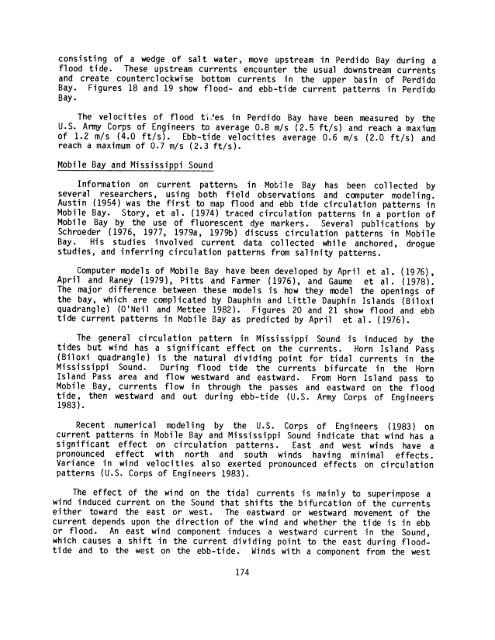ecological characterization atlas of coastal alabama - Data Center
ecological characterization atlas of coastal alabama - Data Center
ecological characterization atlas of coastal alabama - Data Center
You also want an ePaper? Increase the reach of your titles
YUMPU automatically turns print PDFs into web optimized ePapers that Google loves.
consisting <strong>of</strong> a wedge <strong>of</strong> salt water, move upstream in Perdido Bay during a<br />
flood tide . These upstream currents encounter the usual downstream currents<br />
and create counterclockwise bottom currents in the upper basin <strong>of</strong> Perdido<br />
Bay . Figures 18 and 19 show flood- and ebb-tide current patterns in Perdido<br />
B ay .<br />
The velocities <strong>of</strong> flood t-l~es in Perdido Bay have been measured by the<br />
U .S . Army Corps <strong>of</strong> Engineers to average 0 .8 m/s (2 .5 ft/s) and reach a maxium<br />
<strong>of</strong> 1 .2 m/s (4 .0 ft/s) . Ebb-tide velocities average 0 .6 m/s (2 .0 ft/s) and<br />
reach a maximum <strong>of</strong> 0 .7 m/s (2 .3 ft/s) .<br />
Mobile Bay and Mississippi Sound<br />
Information on current patterns in Mob ;le Bay has been collected by<br />
several researchers, using both field observations and computer modeling .<br />
Austi n(1954 ) was the fi rst to map fl ood and ebb ti de ci rc ul ati on patterns i n<br />
Mobile Bay . Story, et al . (1974) traced circulation patterns in a portion <strong>of</strong><br />
Mobile Bay by the use <strong>of</strong> fluorescent dye markers . Several publications by<br />
Schroeder (1976, 1977, 1979a, 1979b) discuss circulation patterns in Mobile<br />
Bay . His studies involved current data collected while anchored, drogue<br />
studies, and inferring circulation patterns from salinity patterns .<br />
Computer models <strong>of</strong> Mobile Bay have been developed by April et al . (1976),<br />
April and Raney (1979), Pitts and Farmer (1976), and Gaume et al . (1978) .<br />
The major difference between these models is how they model the openings <strong>of</strong><br />
the bay, which are complicated by Dauphin and Little Dauphin Islands (Biloxi<br />
quadrangle) (0'Neil and Mettee 1982) . Figures 20 and 21 show flood and ebb<br />
tide current patterns in Mobile Bay as predicted by April et al . (1976) .<br />
The general circulation pattern in Mississippi Sound is induced by the<br />
tides but wind has a significant effect on the currents . Horn Island Pass<br />
(Biloxi quadrangle) is the natural dividing point for tidal currents in the<br />
Mississippi Sound . During flood tide the currents bifurcate in the Horn<br />
Island Pass area and flow westward and eastward . From Horn Island pass to<br />
Mobile Bay, currents flow in through the passes and eastward on the flood<br />
tide, then westward and out during ebb-tide (U .S . Army Corps <strong>of</strong> Engineers<br />
1983) .<br />
Recent numerical modeling by the U .S . Corps <strong>of</strong> Engineers (1983) on<br />
current patterns in Mobile Bay and Mississippi Sound indicate that wind has a<br />
significant effect on circulation patterns . East and west winds have a<br />
pronounced effect with north and south winds having minimal effects .<br />
Variance in wind velocities also exerted pronounced effects on circulation<br />
patterns (U .S . Corps <strong>of</strong> Engineers 1983) .<br />
The effect <strong>of</strong> the wind on the tidal currents is mainly to superimpose a<br />
wind induced current on the Sound that shifts the bifurcation <strong>of</strong> the currents<br />
either toward the east or west . The eastward or westward movement <strong>of</strong> the<br />
current depends upon the di rection <strong>of</strong> the wi nd and whether the ti de i s in ebb<br />
or flood . An east wind component induces a westward current in the Sound,<br />
which causes a shift in the current dividing point to the east during floodtide<br />
and to the west on the ebb-tide . Winds with a component from the west<br />
174
















